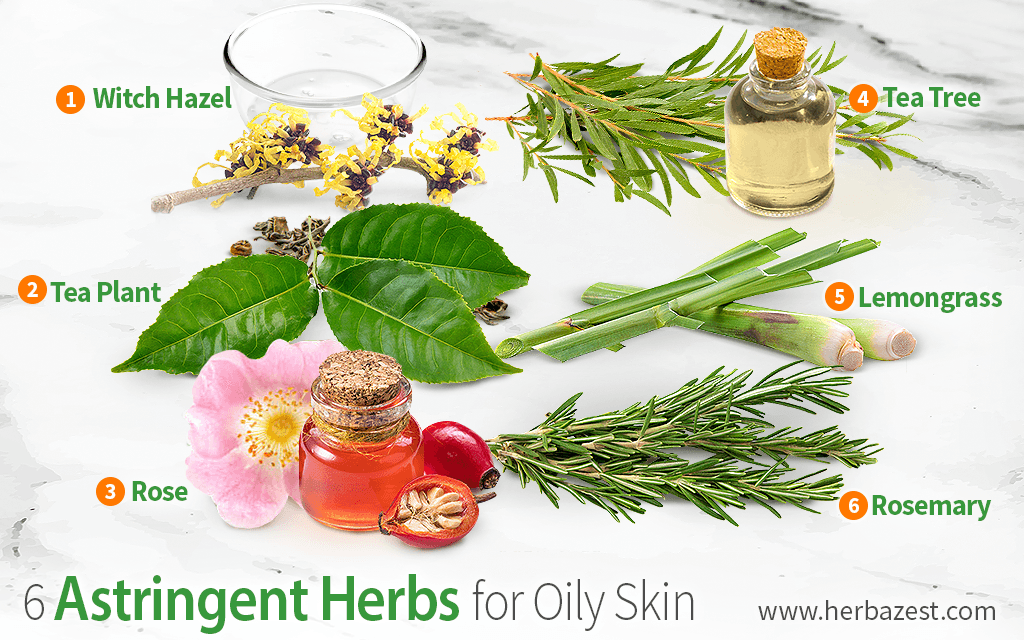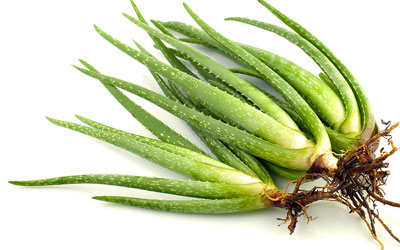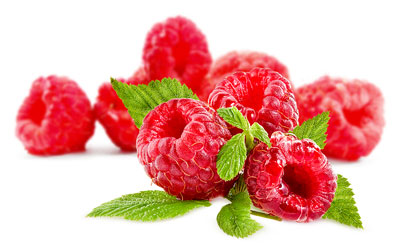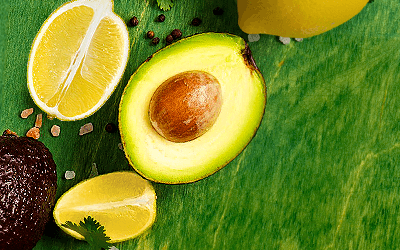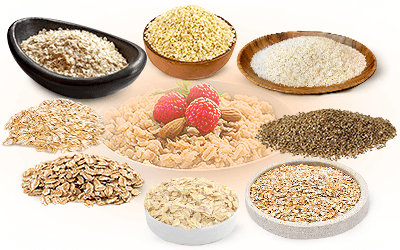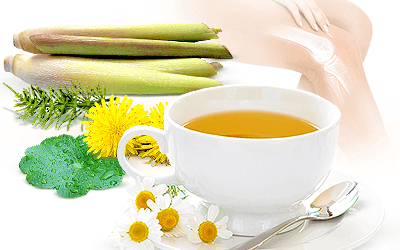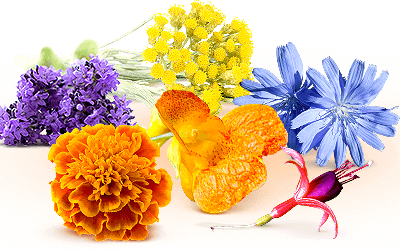Astringents are known for their "drying" property - what is, in actuality, the drawing and constricting of proteins in the cells of the body. Some might describe it as somewhat of a puckering action. This pulling together and tightening produces a number of benefits: it creates a protective barrier against infection, prevents any further inflammation, stops up secretions, and encourages healing.
Thanks to these actions, astringent herbs are great for relieving various ailments, such as diarrhea, urinary issues, or menstrual abnormalities. However, they are perhaps most commonly and effectively used for treating dermatological problems, such as acne and oily skin.
Causes and Signs of Oily Skin
Medically known as seborrhea, oily skin is one of the most common dermatological issues around the world. While it is not a life threatening condition, it can affect the self-esteem and perceived image of the ones who have to deal with it. It is caused by overactive sebaceous glands, and some of the most visible signs of seborrhea are a shinny skin, with or without acne, along with enlarged pores.
Astringent herbs not only act as natural toners, with tightening effects, but also visibly reduce the amount of sebum, slightly drying the skin and giving it a more uniform, smooth appearance. The following herbs for oily skin will not only address the issue on the surface, but can be powerful friends to the body as a whole.
1. Witch Hazel (Hamamelis virginiana)
Witch hazel, native to North America, is perhaps the most famous astringent agent and the go-to for many people with oily skin. It is chock full of tannins, which are the primary culprits behind its potent astringency, but it also contains valuable flavonoids. Extracts of witch hazel have been shown to inhibit Cutibacterium acnes, a gram-positive anaerobic bacilli that naturally lives on the skin but, when it grows out of control, it may cause acne vulgaris, a common inflammatory disorder.1
2. Tea Plant (Camellia sinensis)
Like many astringents, all tea types, including white tea, have a soothing, beneficial effect on skin problems.2 Tea leaves are particularly rich in flavonoids, which are commonly used in the cosmetic industry for their antioxidant and soothing actions. Additionally, the polyphenols contained in tea leaf extracts not only improve skin tone, but also repair UV damage. There is abundant evidence of the beneficial effects of tea's polyphenols over sebum production and common acne through topical application or oral ingestion.3
3. Rose (Rosa canina)
Extracted from the seeds of rosa canina, rosehip oil is a power-house of antioxidant compounds that are highly beneficial for skin health, including phenolic compounds, carotenoids (vitamin A precursors), vitamina C (ascorbic acid), and polyunsaturated fatty acids.4 For this reason, rosehip oil has been traditionally used topically for the treatment of inflammatory skin problems, such as acne and eczema. Due to its astringent properties, rosehip oil is an essential ingredient in many commercial skin toners and do-it-yourself preparations.5
With its soothing and mildly astringent properties, this homemade rose water can be part of your beauty care routine to control oily skin and minimize enlarged pores.
4. Tea tree (Melaleuca alternifolia)
Not to be confused with tea plant, this Australian species has been used in oil form for centuries to treat a number of skin problems, from minor wounds to eczema. Tea tree oil, which is rich in terpinen-4-ol and cineole, has been reported to effectively control sebum levels on skin surface, reducing oiliness and improving general skin appearance, including enlarged pores, comedones, and acne, thanks to its astringent and antiseptic properties.6,7
This chamomile facial toner with tea tree is a great homemade preparation that can help reduce excessive sebum production and improve oily skin.
5. Lemongrass (Cymbopogon citratus)
Lemongrass has been studied to treat a wide variety of health conditions, from anxiety to digestive complains and inflammatory pain. However, the role of lemongrass essential oil in the skin care industry is becoming increasingly relevant due to its strong antioxidant properties. Lemongrass contains high levels of phenols and flavonoids, both of which exert powerful inhibitory effects over the activity of sebaceous glands under the skin surface as well as antimicrobial activities on acne infections.8
This natural homemade deodorant with lemongrass can help control excessive seating and kill the bacteria that cause bad odor under the armpits.
6. Rosemary (Rosmarinus officinalis)
This well-known aromatic, widely used in the kitchen as a condiment, is one of the best astringent herbs for skin. Rosemary concentrates great antioxidant power thanks to its bioactive compounds, mainly carnosol, carnosic acid, and rosmarinic acid, all of which have proven to exert antimicrobial and anti-inflammatory activities that inhibit the expression of pro-inflammatory cytokines that play a role in acne and other dermatological problems.9
A rosemary lemon salt scrub can help relieve inflammation, leaving your skin clean and glowing.
All the aforementioned herbs that reduce sebum production, while also displaying antimicrobial and regenerative properties, can effectively improve oily skin and other dermatological conditions. When used as natural remedies alongside daily self-care routine, these astringent herbs for oily skin can really make a difference.
Sources
- Antioxidants (Basel), Rosmarinus officinalis and Skin: Antioxidant Activity and Possible Therapeutical Role in Cutaneous Diseases, 2023
- BioMed Research International, New Perspectives on Antiacne Plant Drugs: Contribution to Modern Therapeutics, 2014
- Clinical Microbiology Reviews, Melaleuca alternifolia (Tea Tree) Oil: a Review of Antimicrobial and Other Medicinal Properties, 2006
- Frontiers in Pharmacology, Efficacy and safety of Melaleuca alternifolia (tea tree) oil for human health—A systematic review of randomized controlled trials, 2023
- Frontiers in Physiology, Use of Advanced Imaging Techniques for the Characterization of Oily Skin, 2019
- Molecules, Applications of Tea (Camellia sinensis) and Its Active Constituents in Cosmetics, 2019
- Nutrients, Bioactive Compounds for Skin Health: A Review, 2021
- Skin Pharmacology and Physiology, Oily skin: an overview, 2012
- The Journal of Clinical and Aesthetic Dermatology, Oily Skin: A review of Treatment Options, 2017
- Phytotherapy Research, A systematic review on the Rosa canina effect and efficacy profiles, 2008
- American Journal of Clinical Dermatology, Flavonoids as components of biologically active cosmeceuticals, 2008
Footnotes
- Antioxidants (Basel). (2022). Anti-Inflammatory and Anti-Acne Effects of Hamamelis virginiana Bark in Human Keratinocytes. Retrieved May 24, 2023, from: https://pubmed.ncbi.nlm.nih.gov/35740016/
- Journal of Inflammation. (2011). Antioxidant and potential anti-inflammatory activity of extracts and formulations of white tea, rose, and witch hazel on primary human dermal fibroblast cells. Retrieved May 24, 2023, from: https://www.ncbi.nlm.nih.gov/pmc/articles/PMC3214789/
- Antioxidants (Basel). (2017). Green Tea and Other Tea Polyphenols: Effects on Sebum Production and Acne Vulgaris. Retrieved May 24, 2023, from: https://www.ncbi.nlm.nih.gov/pmc/articles/PMC5384166/
- International Journal of Molecular Sciences. (2018). Anti-Inflammatory and Skin Barrier Repair Effects of Topical Application of Some Plant Oils. Retrieved May 24, 2023, from: https://www.ncbi.nlm.nih.gov/pmc/articles/PMC5796020/
- Medicines (Basel). (2018). Total Polyphenol Content and Antioxidant Capacity of Rosehips of Some Rosa Species. Retrieved May 24, 2023, from: https://www.ncbi.nlm.nih.gov/pmc/articles/PMC6165473/
- The Medical Journal of Australia. (1990). A comparative study of tea-tree oil versus benzoylperoxide in the treatment of acne. Retrieved May 25, 2023, from: https://onlinelibrary.wiley.com/doi/abs/10.5694/j.1326-5377.1990.tb126150.x
- Letters in Applied Microbiology. (2008). Comparison of the cidal activity of tea tree oil and terpinen-4-ol against clinical bacterial skin isolates and human fibroblast cells. Retrieved May 25, 2023, from: https://sfamjournals.onlinelibrary.wiley.com/doi/full/10.1111/j.1472-765X.2008.02334.x
- Journal of Microbiologt abd Biotechnology. (2022). Evaluation of the EtOAc Extract of Lemongrass (Cymbopogon citratus) as a Potential Skincare Cosmetic Material for Acne Vulgaris. Retrieved May 25, 2023, from: https://www.ncbi.nlm.nih.gov/pmc/articles/PMC9628876/
- Journal of Medicinal Food. (2013). Rosmarinus officinalis Extract Suppresses Propionibacterium acnes-Induced Inflammatory Responses. Retrieved June 1, 2023, from: https://www.ncbi.nlm.nih.gov/pmc/articles/PMC3624774/


